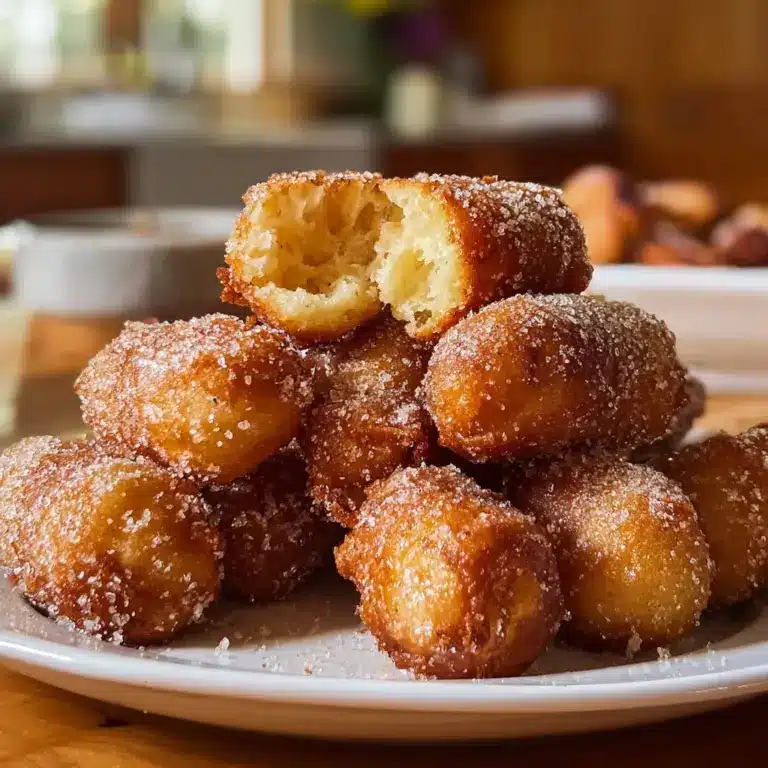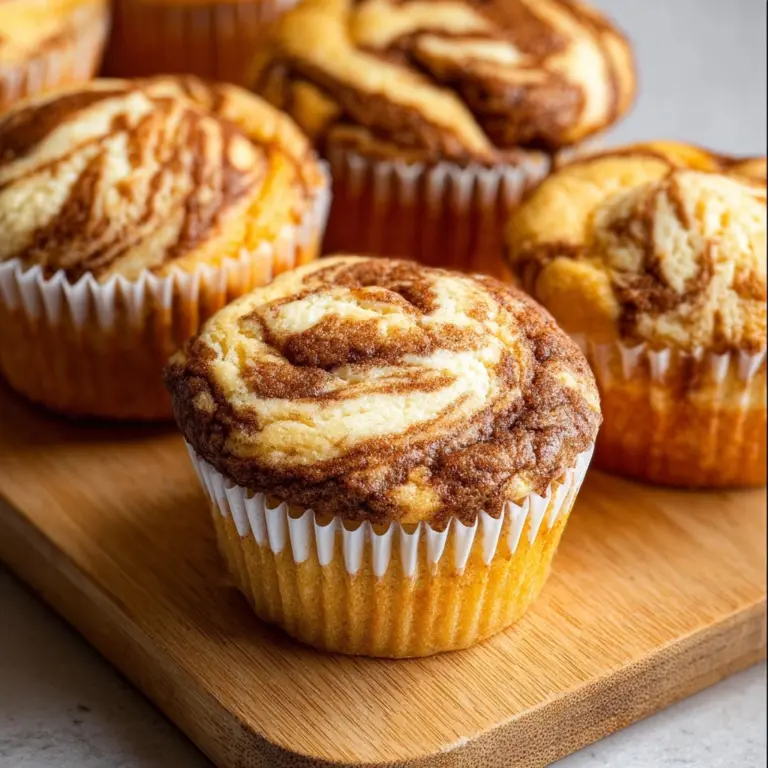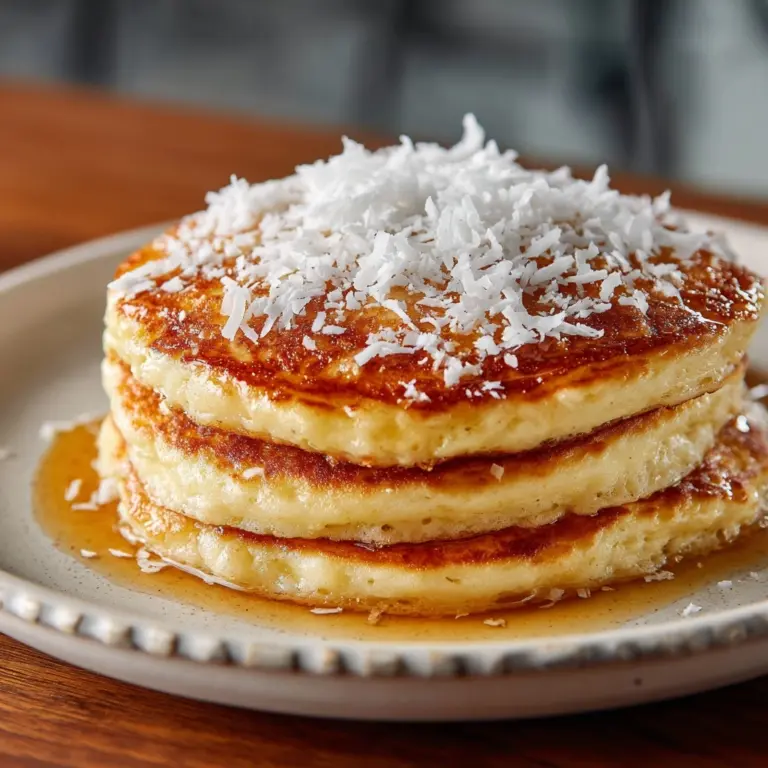Melon Pan Recipe
Introduction
Melon Pan is a delightful Japanese sweet bread known for its soft, fluffy interior and crisp, sugary cookie crust. This recipe guides you step-by-step through making both the bread dough and the signature biscuit topping that creates its iconic texture and flavor.
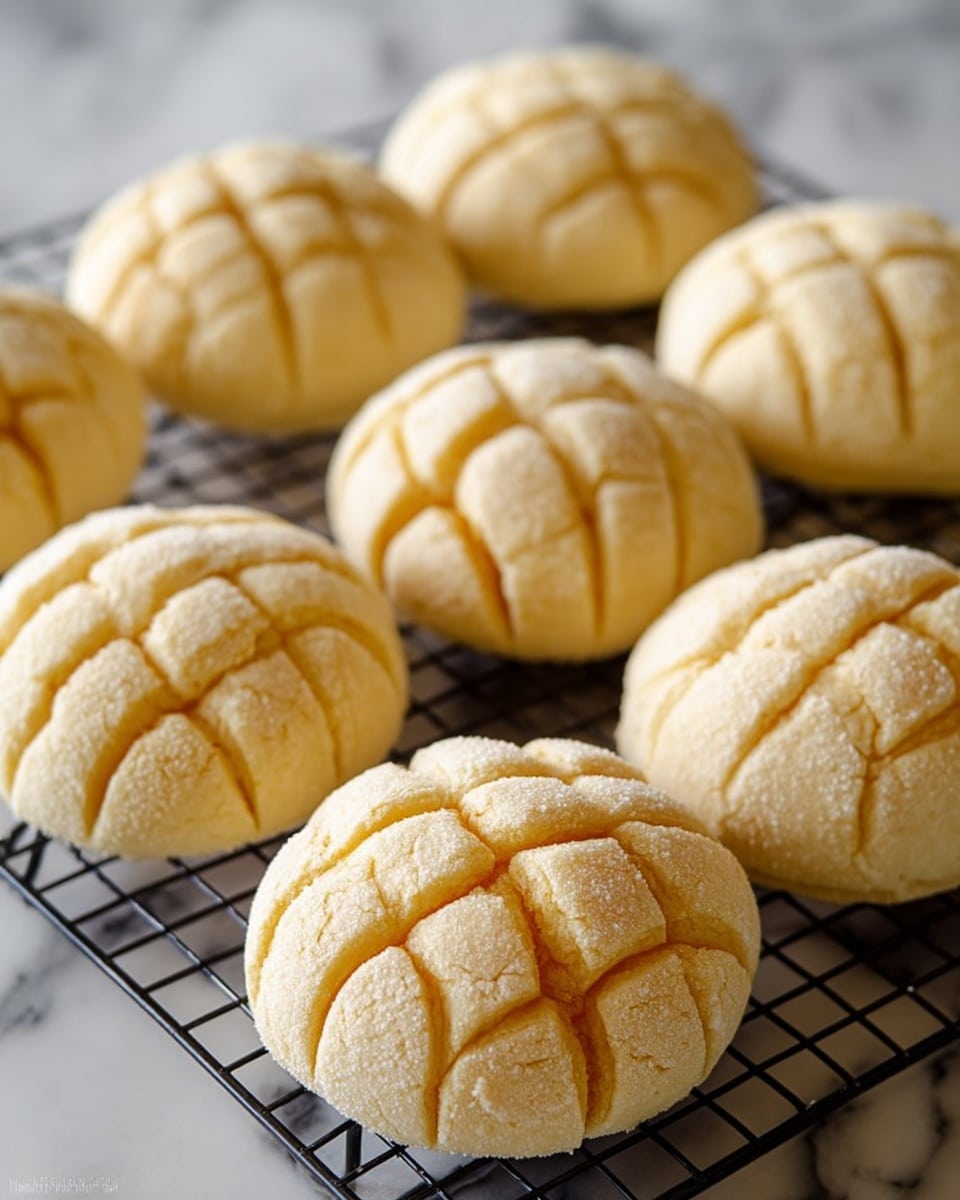
Ingredients
- 225 g bread flour (1¾ cups + 2 Tbsp), plus more for dusting
- 25 g cake flour (3½ Tbsp)
- 1 tsp Diamond Crystal kosher salt
- 3 Tbsp granulated sugar
- 1¼ tsp instant yeast
- 1 large egg (50 g), beaten
- 50 ml whole milk (3 Tbsp + 1 tsp), warmed to 86ºF (30ºC)
- 50 ml water (3 Tbsp + 1 tsp), warmed to 86ºF (30ºC)
- 35 g unsalted butter (2½ Tbsp), cubed and at room temperature
- 60 g unsalted butter (¼ cup), cubed and at room temperature
- 100 g granulated sugar (½ cup)
- 1 large egg (50 g), beaten (for biscuit dough)
- 200 g cake flour (1⅔ cups)
- ½ tsp baking powder
- Additional 2 Tbsp granulated sugar (for topping)
Instructions
- Step 1: Make the Bread Dough. In a large bowl, whisk together 225 g bread flour, 25 g cake flour, 1 tsp kosher salt, and 3 Tbsp sugar. Add 1¼ tsp instant yeast and mix. Stir in the beaten egg, warmed whole milk, and water until a loose, sticky dough forms.
- Step 2: Knead the dough on a lightly floured surface for about 5 minutes, gradually incorporating 35 g cubed butter until the dough becomes elastic and smooth. Perform the slam-and-fold technique for about 10 minutes to develop gluten.
- Step 3: Perform the windowpane test by stretching the dough gently; it should form a thin, translucent membrane without tearing. Shape the dough into a ball, place seam side down in a bowl, cover, and let it rise in a warm spot until doubled in size (1–2 hours).
- Step 4: Make the Biscuit Dough. Mash 60 g butter with 100 g sugar until smooth. Gradually blend in the beaten egg. Sift in 200 g cake flour and ½ tsp baking powder, mixing until just combined. Shape into a ball, divide into 10 equal pieces (about 40–41 g each), roll into balls, and chill for 10 minutes.
- Step 5: Prepare the Bread Dough for Shaping. Deflate the risen dough on a floured surface, fold edges inward, and roll into a ball. Divide into 10 equal pieces (46–47 g each), shaping each into a smooth ball. Rest covered for 15 minutes.
- Step 6: Shape the Melon Pan. Flatten each chilled biscuit dough ball into a 4-inch circle. Flatten each bread dough ball and fold edges inward to form a ball. Place the bread dough ball on the center of the biscuit dough circle, flip so biscuit dough is on top, and gently wrap the biscuit dough around it, leaving the bottom exposed.
- Step 7: Coat each melon pan with 2 Tbsp granulated sugar, dusting off excess. Score a crisscross pattern about ⅛ inch deep on the biscuit dough using a knife or scraper.
- Step 8: Place assembled melon pan on a baking sheet, cover with plastic wrap, and proof in a warm place until the dough increases to 1½ times its size, about 50 minutes.
- Step 9: Preheat the oven to 350ºF (180ºC) during proofing. When ready, bake melon pan for 13–15 minutes until the biscuit crust is lightly golden. Rotate the tray halfway through if needed for even browning.
- Step 10: Cool the melon pan on a wire rack for 5 minutes before serving. Enjoy fresh or follow storage instructions below.
Tips & Variations
- Use whole milk warmed to 86ºF (30ºC) for a richer dough and better yeast activity.
- If using active dry yeast, activate it in warm water before adding to the flour mixture.
- Lightly dust your hands with bread flour during kneading to prevent sticking, but avoid adding too much to keep dough soft.
- For a fun twist, add matcha powder to the biscuit dough or sprinkle cinnamon sugar on top before baking.
- Use a metal or silicone dough scraper to handle sticky dough and keep your workspace clean.
Storage
Once completely cooled, wrap each melon pan individually in plastic wrap to avoid drying out. Store in an airtight container in the refrigerator for up to 3 days, or freeze for up to one month. To reheat, thaw overnight in the refrigerator or microwave briefly, then bake at 350ºF (180ºC) until the crust is crisp again.
How to Serve
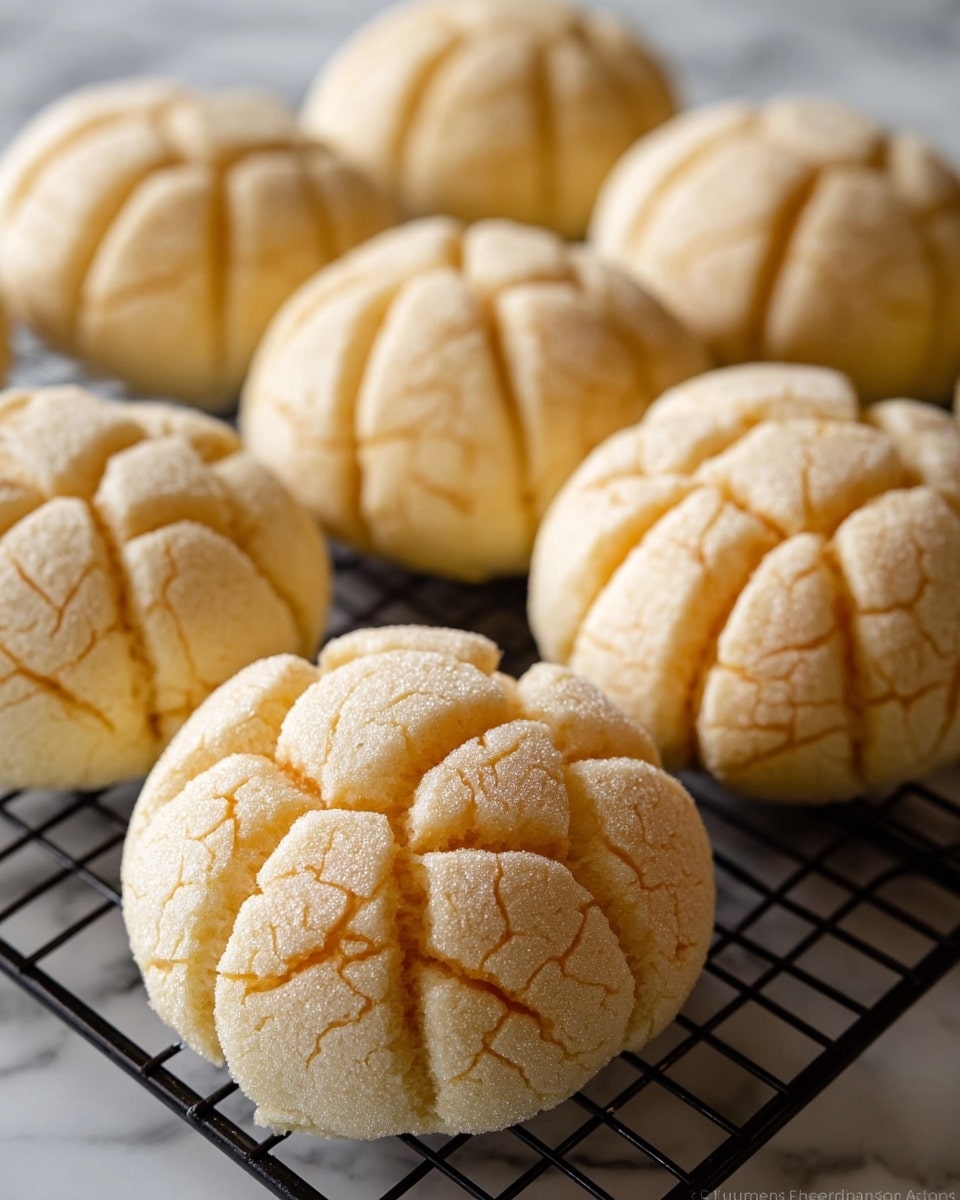
Serve this delicious recipe with your favorite sides.
FAQs
Can I use all-purpose flour instead of bread flour?
While you can substitute all-purpose flour, bread flour is recommended because its higher protein content develops better gluten, resulting in a chewier, softer bread texture essential for melon pan.
How do I know when the dough has risen enough?
Perform the finger poke test: gently press your floured finger into the dough’s surface. If the indentation stays and doesn’t spring back immediately, the dough has risen sufficiently and is ready for the next step.
Print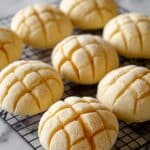
Melon Pan Recipe
- Total Time: 2 hours 45 minutes
- Yield: 10 melon pan buns 1x
- Diet: Vegetarian
Description
Melon Pan is a delightful Japanese sweet bread known for its soft, fluffy interior covered with a thin, crispy cookie crust. This recipe guides you through making both the bread dough and the biscuit dough separately before combining them. The result is a beautifully round bun with a signature crisscross pattern, lightly sweetened and baked to golden perfection.
Ingredients
Bread Dough
- 225 g bread flour (1¾ cups + 2 Tbsp; plus more for dusting)
- 25 g cake flour (3½ Tbsp)
- 1 tsp Diamond Crystal kosher salt
- 3 Tbsp granulated sugar
- 1¼ tsp instant yeast
- 1 large egg (50 g, beaten)
- 50 ml whole milk (3 Tbsp + 1 tsp; at 86ºF/30ºC)
- 50 ml water (3 Tbsp + 1 tsp; at 86ºF/30ºC)
- 35 g unsalted butter (2½ Tbsp; cubed; at room temperature)
Biscuit Dough
- 60 g unsalted butter (¼ cup; cubed; at room temperature)
- 100 g granulated sugar (½ cup)
- 1 large egg (50 g, beaten)
- 200 g cake flour (1⅔ cups)
- ½ tsp baking powder
- 2 Tbsp granulated sugar (for topping)
Instructions
- Prepare Ingredients: Weigh and measure all ingredients accurately, preferably with a kitchen scale for best results.
- Make Bread Dough – Mix Dry Ingredients: In a large bowl, whisk together bread flour, cake flour, kosher salt, granulated sugar, and instant yeast.
- Add Wet Ingredients: Add the beaten egg, whole milk, and water (both warmed to 86ºF/30ºC). Mix until the dough comes together into a loose, sticky ball.
- Knead Bread Dough: Transfer dough to a floured surface and knead for 5 minutes. Incorporate the cubed unsalted butter gradually, rolling it into the dough. Continue kneading and perform a slam and fold technique to develop gluten further until dough is smooth and elastic (about 10 minutes). Conduct a windowpane test to ensure proper gluten formation.
- Bulk Fermentation: Shape dough into a ball, place seam side down in a bowl, cover with plastic wrap, and let rise in a warm place for 1–2 hours until doubled in size.
- Make Biscuit Dough – Cream Butter and Sugar: In a clean bowl, mash butter until smooth. Add sugar and mix until blended. Gradually incorporate beaten egg in small amounts. Sift in cake flour and baking powder. Mix only until combined and form into a ball.
- Divide Biscuit Dough: Weigh total biscuit dough (~400–410 g), divide into 10 equal parts (~40–41 g each), shape into balls. Chill in refrigerator for 10 minutes to firm up.
- Divide Bread Dough: Deflate the fermented dough, roll it into a ball, and divide into 10 equal pieces (~46–47 g each). Shape into smooth balls and let rest covered for 15 minutes.
- Shape Melon Pan: Roll each biscuit dough ball into a 4-inch circle. Flatten each bread dough ball, fold sides inward in thirds, pinch to seal, then roll into a smooth ball. Place the bread dough ball on the biscuit dough circle, seam side up; flip so biscuit dough is on top, gently pull biscuit dough around bread dough, leaving base uncovered.
- Add Sugar Topping and Score: Dip assembled dough in granulated sugar, tapping off excess. Using a knife or scraper, score crisscross lines (three horizontal, three vertical, about ⅛ inch deep) on biscuit dough.
- Final Proof: Place melon pan on baking sheet lined with parchment paper or silicone mat. Cover loosely and let rise in a warm place until 1.5 times original size, about 50 minutes.
- Preheat Oven: Preheat to 350ºF (180ºC), placing rack in center position.
- Bake: Remove plastic wrap and bake melon pan for 13–15 minutes until biscuit crust is light golden brown. Rotate baking sheet halfway if browning unevenly. Avoid overbaking to keep moist.
- Cool and Enjoy: Transfer baked melon pan to a wire rack and let cool for 5 minutes before serving.
- Storage: Once cooled, wrap individually in plastic wrap and store in airtight container in refrigerator up to 3 days or freeze for up to 1 month. Reheat in microwave or oven (350ºF) to crisp the crust.
Notes
- Using a kitchen scale ensures accuracy for the best results.
- Whole milk is recommended over reduced-fat milk for richer flavor and better dough texture.
- Adjust proofing time according to your environment; use the oven’s Proof setting or a warm, steamy place for bulk fermentation and final proof.
- Be gentle when scoring the biscuit dough to avoid tearing.
- Do not cover the base of the bread dough with biscuit dough to allow proper rising and baking.
- Windowpane test ensures gluten development essential for soft, elastic bread dough.
- Use parchment paper or silicone mats to prevent sticking during proofing and baking.
- Rotate baking sheet during baking if necessary for even browning.
- Melon Pan is best enjoyed fresh but can be stored as described.
- Prep Time: 40 minutes
- Cook Time: 15 minutes
- Category: Bread
- Method: Baking
- Cuisine: Japanese
Keywords: melon pan, Japanese sweet bread, soft bread, cookie crust, baking, bread recipe, sweet bun

